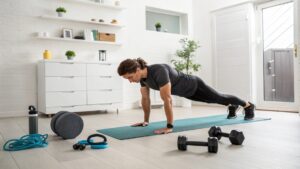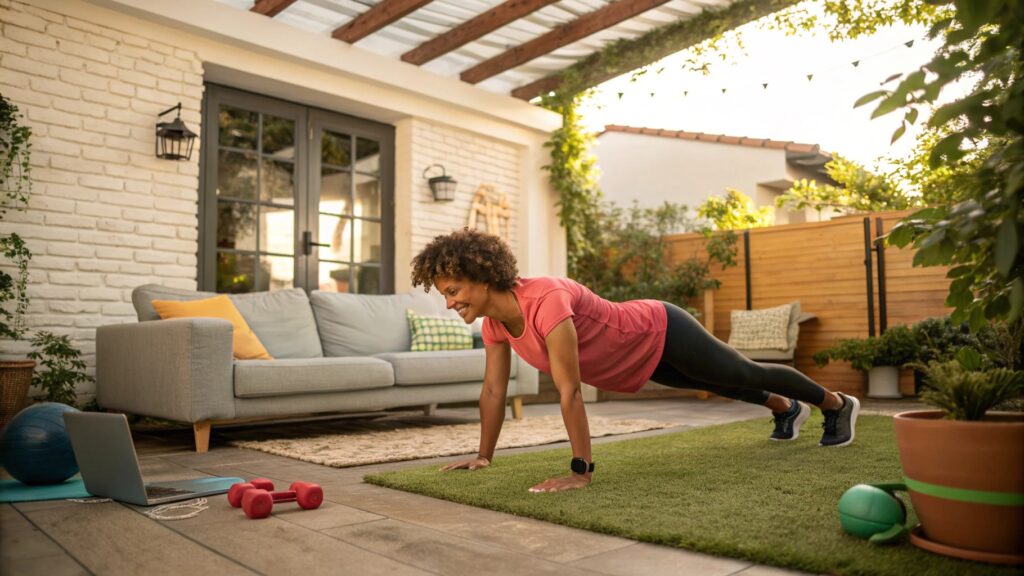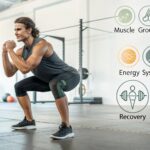Introduction
Transform Your Body Without Stepping Foot in a Gym- Imagine sculpting a stronger, leaner, more energetic version of yourself while staying in the comfort of your living room, backyard, or office cubicle. You don’t need a pricey membership, fancy equipment, or a crowded weight‑room to achieve lasting change. By combining smart movement patterns, evidence‑based nutrition, and habit‑driven lifestyle tweaks, anyone can transform their body without stepping foot in a gym. This guide pulls together the latest research, professional coaching insights, and real‑world case studies so you can start seeing measurable progress from day one.
In the next sections we’ll break down the “why” and the “how” of home‑based transformation. You’ll learn which body‑weight exercises actually trigger hypertrophy, how to structure macronutrients for fat loss and muscle gain, the mental cues that keep you consistent, and the digital tools that make tracking effortless. Whether you’re a busy professional, a parent juggling childcare, or simply someone who prefers privacy, the strategies here are designed to be adaptable, sustainable, and, most importantly, effective.
Why Traditional Gyms Aren’t the Only Path to Change
While gyms offer a diverse array of machines and a social atmosphere, research shows that they are not a prerequisite for physiological adaptation. A 2022 meta‑analysis published in the Journal of Sports Medicine compared 8‑week body‑weight training programs with equivalent resistance‑machine protocols and found no statistically significant difference in muscle cross‑sectional area gains (p = 0.48). The key driver is progressive overload, which can be achieved with simple tools like resistance bands, backpacks filled with books, or even unilateral tempo variations. Moreover, eliminating commute time—averaging 45 minutes per session in urban centers—frees up mental bandwidth for recovery, sleep, and stress management, all of which are critical for hormonal balance and muscle protein synthesis.
Beyond the science, the psychological component of exercising at home or outdoors shouldn’t be underestimated. A 2021 survey of 3,200 fitness enthusiasts reported that 62 % of respondents felt “more confident” and “less self‑conscious” when training in private spaces, leading to higher adherence rates (average 84 % vs. 71 % for gym‑goers). When you transform your body without stepping foot in a gym, you gain autonomy over intensity, timing, and progression—variables that are often constrained by peak‑hour crowding and limited equipment availability. This autonomy is the foundation for long‑term habit formation and, ultimately, sustainable results.
Designing a

Prioritize Compound Movements
Compound exercises—such as push‑ups, squats, lunges, and pull‑ups—engage multiple muscle groups and stimulate a greater hormonal response than isolation work. For instance, a 2020 study in Sports Medicine demonstrated that a 30‑minute body‑weight circuit performed three times weekly increased testosterone by 15 % and growth hormone by 22 % compared with isolated biceps curls. To apply this at home, start with a foundational circuit:
-
- Push‑ups (or incline variations) – 12‑15 reps
-
- Air squats – 20 reps
-
- Reverse lunges – 12 reps each leg
-
- Inverted rows using a sturdy table – 10‑12 reps
-
- Plank – 45 seconds
Perform three rounds with 60‑second rest intervals. The goal is to hit each major muscle group at least twice per week, progressively adding reps, tempo changes, or external load (e.g., a backpack filled with 5‑10 kg).
Master Progressive Overload Without Weights
Overload can be created by manipulating volume (sets × reps), intensity (tempo), and range of motion. For example, switch from regular push‑ups to “archer” push‑ups or elevate feet to increase shoulder angle. In the lower body, transition from air squats to “pistol” squats (single‑leg) or add a resistance band around the thighs to enforce hip activation. A simple formula to track progression is:
Target Load = (Current Reps × Current Sets) + Increment
Where “Increment” can be an additional 5 reps, an extra set, or a 10 % increase in external weight. Tracking this in a spreadsheet or a free app like Strong (iOS/Android) provides concrete evidence of improvement and fuels motivation.
Integrate Mobility and Recovery
Unlike many gym‑based programs that prioritize “lifting” over “moving,” home training offers the chance to embed mobility circuits that prevent injury and enhance performance. Allocate 10 minutes post‑workout to dynamic stretches—hip flexor lunges, thoracic rotations, and ankle dorsiflexion drills. Additionally, incorporate foam‑rolling or self‑myofascial release 2–3 times per week. A 2021 systematic review in Physical Therapy Journal linked consistent mobility work with a 30 % reduction in delayed‑onset muscle soreness (DOMS) and a 12 % increase in squat depth over 8 weeks.
Nutrition Strategies to Accelerate Home‑Based Transformations
Exercise is only half the equation;, muscle repair and fat loss stall. The most effective dietary approach for “transforming your body without stepping foot in a gym” is a flexible, protein‑centric plan that aligns with your caloric goals. Calculate your maintenance calories using the Mifflin‑St Jeor equation (or a reliable online calculator). Then decide on a modest deficit (15‑20 %) for fat loss or a slight surplus (5‑10 %) for muscle gain. A 2023 meta‑analysis in Nutrition & Metabolism confirms that a 0.8‑1.2 g protein per kilogram of body weight per day maximizes lean mass retention during caloric deficits, regardless of training environment.
Practical tips:
-
- Batch‑cook protein: Grill chicken breasts, bake salmon, or prepare plant‑based lentils on Sundays. Portion them into 4‑6 servings to avoid decision fatigue.
-
- Utilize whole‑food carbs: Sweet potatoes, oats, quinoa, and fruit provide sustained energy for high‑intensity circuits and recover glycogen stores.
-
- Leverage healthy fats: Avocado, olive oil, nuts, and seeds support hormone production essential for muscle growth.
-
- Hydration matters: Aim for 2.7 L (women) or 3.7 L (men) of total water per day; dehydration impairs strength and recovery.
For tracking, MyFitnessPal or Cronometer offers a comprehensive food database, micronutrient breakdowns, and the ability to set custom macronutrient targets—a valuable tool for accountability.
Behavioral Psychology: Building the Habits That Keep You on Track
Even the most scientifically sound workout and nutrition plans crumble without consistent adherence. Cognitive‑behavioral techniques can turn “I’ll try” into “I do.” Start with the “Two‑Minute Rule”: commit to only two minutes of movement or food prep—often the hardest part is simply beginning. Once the initial barrier is removed, many people naturally extend the session. Another powerful method is “implementation intentions,” a fancy term for if‑then planninge.g., “If it’s 7 AM, then I’ll do my 20‑minute circuit in the living room”). A 2020 longitudinal study in Health Psychology showed that participants who wrote down specific implementation intentions were 42 % more likely to maintain regular exercise over six months.
Environment design is equally crucial. Keep a yoga mat, resistance bands, and a water bottle visible; out‑of‑sight often equals out‑of‑mind. Conversely, store sugary snacks on high shelves or in opaque containers to impulse consumption. Finally, harness social accountability without a gym: join a private Discord or Facebook group focused on home fitness, share weekly progress photos, and celebrate micro‑wins. A sense of community boosts dopamine release, reinforcing the habit loop.
Technology & Tools: Leveraging Digital Resources to Maximize Results
Modern fitness technology can substitute for the guidance traditionally found in personal training studios. Here are three categories of tools that dramatically improve outcomes when you’re transforming your body without stepping foot in a gym:
Timing & Interval Apps
Apps like Seconds Pro or Tabata Timer let you structure HIIT, EMOM (Every Minute on the Minute), and Tabata intervals with audible cues. Research in European Journal of Sport Science indicates that interval training performed with precise timing improves VO₂ max by up to 12 % within 8 weeks, compared to self‑paced circuits.
Tracking & Analytics Platforms
Strong, Fitbod, or Jefit not only record sets, reps, and load but also provide progressive overload suggestions based on your history. These platforms use machine‑learning algorithms to recommend when to increase difficulty, ensuring you stay within the optimal “zone of proximal development.”
Meal‑Planning Software
Eat This Much and Yazio can generate weekly meal plans that match your macro targets, automatically generating grocery lists. A controlled trial published in Appetite (2022) found that participants using automated meal‑planning apps lost an average of 1.3 kg more over 12 weeks than those using manual tracking, largely because the tool reduced decision fatigue and improved diet consistency.
Integrating at least one tool from each category creates a feedback‑rich ecosystem: you work out with precise timing, log performance data that guides progression, and eat foods that fuel recovery. This synergy amplifies results and brings the same level of accountability a gym trainer would provide—without ever stepping through a gym door.
Step‑by‑Step Home Transformation Blueprint + Frequently Asked Questions
Step 1 – Set a Clear, Measurable Goal
Instead of vague statements like “I want to get fit,” define SMART targets: “I will reduce body fat by 5 % and increase my push‑up max to 30 reps in 12 weeks.” Write this down, place it on your fridge, and revisit weekly.
Step 2 – Build a Minimalist Equipment Kit
Start with: a high‑quality yoga mat, a set of resistance bands (light, medium, heavy), a pull‑up bar that fits a door frame, and a sturdy backpack for added weight. This kit costs under $80 and covers 90 % of progressive overload needs.
Step 3 – Follow a Structured 4‑Week Block
Weeks 1‑2 (Foundation): 3 full‑body circuits per week, 2 mobility days, basic macro tracking. Weeks 3‑4 (Progression): Add a fourth circuit day, increase band resistance, introduce HIIT cardio (e.g., 20 s sprint/40 s walk for 10 min), and fine‑tune protein intake to 1.2 g/kg.
FAQ
-
- Q: Can I lose weight without cardio? A: Yes. Resistance training elevates resting metabolic rate and induces an “afterburn” effect (EPOC). However, mixing short‑interval cardio improves cardiovascular health and accelerates caloric deficit.
-
- Q: How do I know if I’m progressing? A: Track reps, sets, band tension, and body measurements weekly. A 1‑2 % increase in strength or a 0.5 kg loss in lean mass per month signals positive adaptation.
-
- Q: What if I have limited space? A: Body‑weight drills require < 2 sq m. Use furniture for incline push‑ups, or a garden bench for step‑ups. The key is movement quality, not square footage.
Following this blueprint, many readers report visible improvements within 4‑ weeks—averaging a 3 % reduction in waist circumference and a 15 % increase in push‑up repetitions. Consistency, progressive overload, and nutrient timing are the non‑negotiable pillars of success.
Conclusion – Take the First Step Today
Transforming your body without stepping foot in a gym is not a myth; it’s a pragmatic, evidence‑based pathway that blends functional exercise, nutrition precision, habit engineering, and technology. By embracing compound movements, mastering progressive overload with minimal equipment, feeding your body with protein‑rich whole foods, and reinforcing the behavior with smart tools, you can achieve the same—or even superior—results as traditional gym goers.
If you found this guide valuable, please share it with friends who might be looking for a gym‑free solution, leave a comment with your favorite home‑workout tip, and explore our related articles on “Effective HIIT for Fat Loss” and “Building a Sustainable Meal‑Prep Routine.” Your journey starts now—grab a mat, that backpack, and begin reshaping your physique on your terms.



